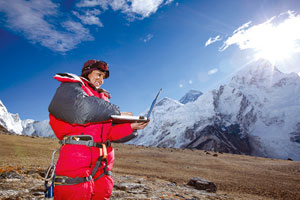 Ncell launched 3G services at Kala Pathar (5,675 m) in 2010 |
This spring, he returned to Everest Base Camp and was surprised to find 3G mobile phones and cyber cafes all the way from Namche to Gorakshep.
"It's incredible, pretty soon there is going to be no point on earth without phones and the Net," he said.
While the mountains look the same, (except perhaps for the receding glaciers) Namche has turned into a bustling modern town. But what is completely new is the sight of porters talking on their mobiles or listening to music blaring from their cell phone speakers while they haul 40 kg of mountaineering gear on their backs.
In the last two years, mobile penetration rate across 75 districts of Nepal has increased from 32 to 55 per cent. Mobile telephony has been able to leap frog the digital divide and bypass the restrictions of landlines. With mobile phones, Internet penetration rate in Nepal has also increased from 6 per cent two years ago to 18 per cent now.
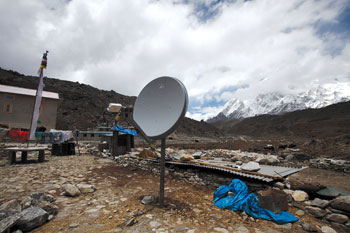 A satellite dish at a hotel in Lobuje |
"We have had video conferencing up to the second camp on Everest through Ncell 3G," says Laxman Adhikari, a climate researcher at the Pyramid International Observatory in Lobuje.
While telecom firms have recently begun expanding their base stations in the higher areas like Khumbu, many companies have been providing satellite solutions to expedition groups and hotels in the area for almost a decade now.
The most popular are satellite phones that are sold in Nepal by Thuraya and bypass domestic networks and go directly to satellite. Thuraya's handsets are now so small they look indistinguishable from cell phones.
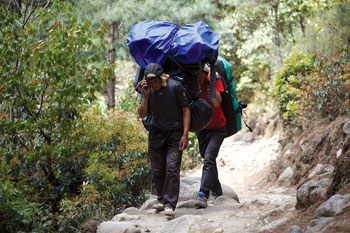 A porter talks on a mobile phone on his way to Namche |
VSAT receives/transmits signals from terminals installed at dispersed sites connecting to a central hub via Satellite using small diameter antenna dishes. The technology is now increasingly popular among hotel and lodges in the region as trekkers look for connectivity even at the wilderness of the Himalaya.
The higher you go up the mountain, the higher the price of the internet at the trekking lodges. Alpine Inn in Lobuje provides wifi Internet to its guests at Rs 1000 per hour. But given that their monthly cost for Internet during tourist season is Rs 20,000, the inn barely breaks even. So why do they do it?
"We make our money from the food and drinks they buy here, and they come because of the Internet," explains Mingma Tsering Sherpa of Alpine Inn. But with smart phones and mobile Internet, cyber cafes are starting to lose business.
Tseten Sherpa of Sherpa Internet Caf� at Dingboche says that the business has gone down over the years due to the use of Internet through mobile phones. "Mobile phones now work even as high as Gorakshep and the base camp so we are virtually out of business," says Tseten.
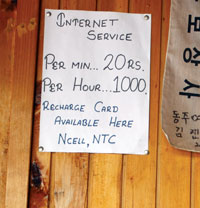 Internet rates pinned on the notice board of a hotel in Lobuje. |
Despite this, the Internet boom is impacting not just tourism but health and education in the Khumbu. Khumjung High School, one of many schools established by Edmund Hillary, has computer classes and will be expanding the existing wireless Internet connection later this year.
"Although computer education isn't compulsory here, interested students in sixth grade and above attend computer classes after school," says principal Mahendra Kathet. He hopes that with Internet accessibility, which has been made easier and affordable through Nepal Telecom's ADSL landline connection, students in Khumjung won't be left behind their city peers.
Khunde Hospital has also benefited from the Internet because doctors there regularly use telemedicine to consult specialists in Kathmandu and abroad.
Eliza Bajracharya, physician at Khunde Hospital told Nepali Times: "The Internet has transformed the way we do work. It also allows us to keep in touch with our families and this makes us feel less like we are in a remote area."
See also:
Upwardly mobile
Nepal posts one of highest growth rates in mobile phones for TeliaSonera
Beyond the digital divide, WONG SHU YUN in MYAGDI
Mahabir Pun proves that there is life after a Magsaysay
Empowering technology
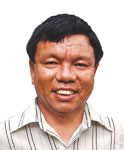 |
Pun, who is a recipient of the Ramon Magsaysay Award, believes that unless technology is used to empower local people by uplifting their socio-economic conditions, its transformative power will go to waste.
"The Internet is more than a tool, it is a necessity and offers rural areas the chance to catch up with the city," Pun told Nepali Times.
Worldlink will provide Internet access to rural schools and health centres at minimal cost to help develop social infrastructure, and transform access to communication in rural Nepal.
Read also:
High connections


